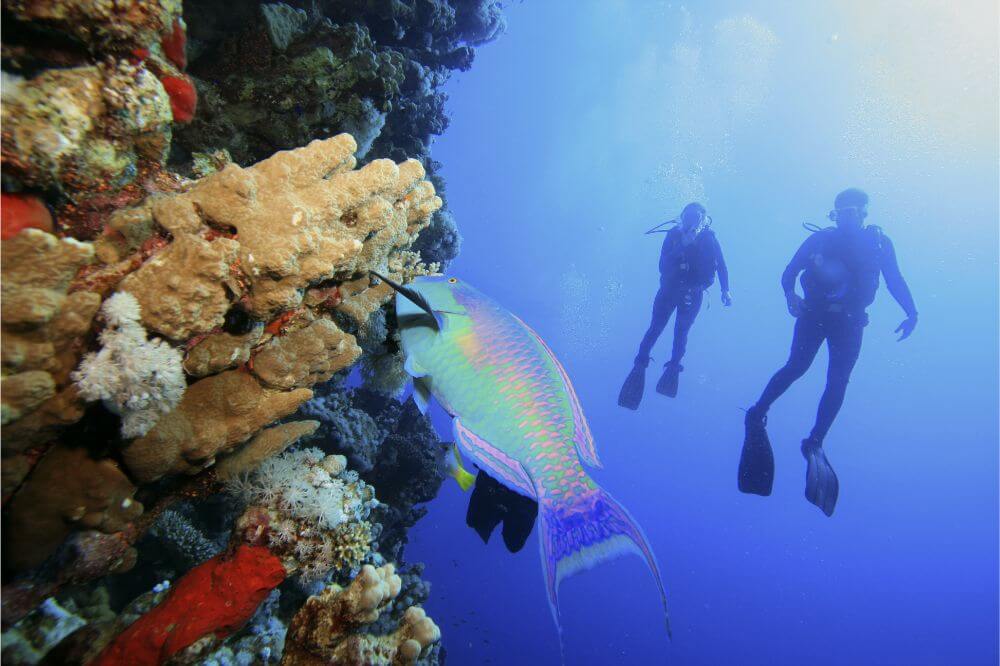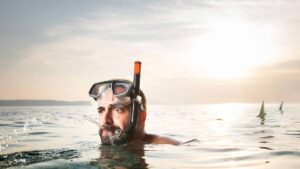Parrotfish are at the top of the list of beautiful fish you can see when scuba diving.
As you are about to find out, these fish get their unique name, not due to their coloration, but for another feature, they share with those talkative birds.
These are some of the most colorful fish, and if you go scuba diving near coral reefs, you are very likely to see one.
Let’s discuss what you need to know about scuba diving with these incredible fish.
Contents
Parrotfish: The Basics
First, there are roughly 90 different species of parrotfish, with the vast majority being found in the Indo-Pacific region of the world.
Second, in terms of size, most species measure around 50 centimeters or 20 inches in length, although some species of parrotfish can grow up to 1.3 meters.
As you can tell by their name, these fish are very colorful and are usually covered in various patterns featuring bright blues, greens, yellows, orange, purple, red, just like real parrots.
The reason these fish are called parrotfish is because of how their jaws and teeth grow.
Parrotfish teeth grow on the outside of the jaw, and they come to a point forming what looks like a parrot’s beak.
Another interesting is that many species will extrude a particular type of mucus and form a mucus cocoon during the nighttime, which is thought to help hide their scent from predators, and serve as an early warning system when the cocoon is broken.
Are Parrotfish Dangerous?
The remarkable thing about scuba diving near parrotfish is that they are peaceful, unlike many other fish.
Most parrotfish are herbivorous, which means that they only eat plants and have absolutely no desire to attack you.
Moreover, this type of fish is generally quite frightful and skittish in nature, which means that it really wants nothing to do with humans.
When scuba diving with parrotfish, you have nothing to worry about aside from the bigger predators that are gunning to eat them.
Moreover, if you are very quiet and peaceful, then it is likely that parrotfish will swim near you as they are known for swimming near scuba divers.

Where to Dive with Parrotfish
You don’t have to go very far to see parrotfish while scuba diving.
There are many different species of parrotfish, and they can be found in both subtropical and tropical oceans around the world.
However, parrotfish are most commonly found in the Indo Pacific oceans of the world and can be readily found in the Indian Ocean, the Pacific Ocean, and the Atlantic Ocean.
We aren’t going to start listing specific locations because these parrotfish can be found in many places.
As long as you are near a healthy coral reef and are between 5 and 15 feet deep, you are very likely to see parrotfish.
Some are known to swim as deep as 100 feet in search of food, but that said, you probably won’t be going that deep.
Best Time of Year to Dive with Parrotfish
You can dive year-round to see parrotfish.
However, the best time to see any kind of fish is when they spawn because when fish spawn, they usually gather in large groups.
Parrotfish breed year-round, and you can also find large groups no matter the month.
Keep in mind that parrotfish are not really nocturnal, as they actually develop themselves in a mucus cocoon at night.
So, if you want to see parrotfish and get the most out of their bright colors, go during the day.
Generally speaking, the best times to go are at dawn or dusk when fish are feeding.
Tips for Diving with Parrotfish
- The best time to see parrotfish while scuba diving is right at dawn.
- Although large schools of parrotfish are known to swim around scuba divers, be aware that these fish are somewhat frightful, so moving quickly is not recommended if you don’t want to scare them.
Wrapping Up
When it comes down to it, the parrotfish is one of the most beautiful fish you will ever see.
So, if you go scuba diving, we recommend looking out for them.





